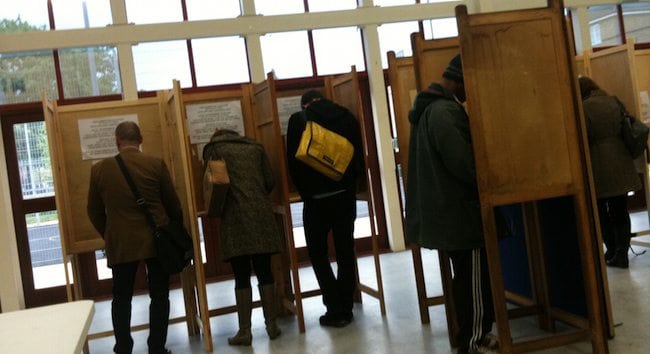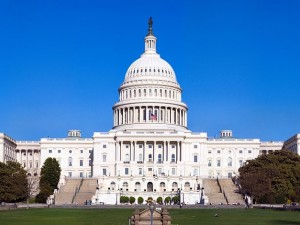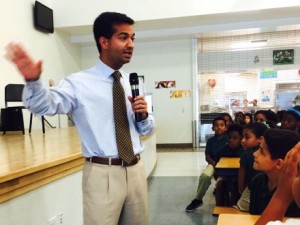By D.R. Tucker
Change doesn’t happen unless people vote for it — and the changes needed to expedite our country’s shift away from fossil fuels won’t occur on a scale dramatic enough to avert the worst impacts of the climate crisis unless legions of voters focused on protecting future generations show up to vote consistently. This is the philosophy behind the Environmental Voter Project, a new nonpartisan initiative by veteran political consultant Nathaniel Stinnett to identify, register and motivate climate-concerned citizens to make their voices heard every Election Day.
Stinnett launched this effort in 2015 due to concerns about the climate crisis being trumped by other issues. “For years,” Stinnett says, “I’d been frustrated that voters always list climate change and other environmental issues among their lowest priorities when voting. This has a huge impact on policy-making because if voters don’t prioritize environmental issues, why should we expect politicians to?
“Then, in early 2014, my research revealed some really surprising data: namely, that there are actually tens of millions of Americans who deeply care about the environment as one of their top political priorities…but these people are awful voters, so they never show up in likely voter polls and they’re never targeted by political campaigns. This made me realize that the environmental movement may not have a ‘persuasion’ problem; instead, we may just have a ‘turnout’ problem. And that’s good news because getting an already-persuaded environmentalist to vote is far easier (and cheaper) than persuading a non-environmentalist to begin caring about the environment.”
Stinnett continues, “I then spent over a year talking to environmental leaders around the country, fine-tuning our ideas, and building a team. Over the summer of 2015, we crowd-funded $400,000 from over 500 people, and then we launched our nonprofit on October 1, 2015.”
Stinnett explains his methodology: “Using big data analytics and data-rich voter files, we ran huge surveys to determine which types of people were most likely to list the environment as one of their top political priorities. Hundreds of consumer data points were used to help us identify these people. We then built large predictive models that assigned ‘environmental voter scores’ to each voting eligible citizen in these databases. We submitted these scores to outside testing and – when surveyed – 89% of the people we identified confirmed that the environment was one of their top two most important issues…which is a level of accuracy that’s almost unheard of.
“Since each person’s voting history is public record,” Stinnett notes, “the next and final step is an easy one. We simply filter out all of the regular voters, so that we can focus only on the super-environmentalists who don’t vote. Across the country, we’ve identified 15.78 million super-environmentalists who never (or almost-never) vote.”
Stinnett’s efforts are already showing tangible results. “Our ‘proof of concept’ test-run was in the November, 2015, Boston municipal elections, where we divided the identified environmental non-voters into a ‘test group’ and a ‘control group.’ We didn’t contact the control group at all, and they had an 8.1% turnout on Election Day. In contrast, our ‘test group’ had an 11.5% turnout, meaning that our techniques boosted turnout by 3.4% and increased our targets’ overall likelihood of voting by 40%. 3.4% is a big deal in the election business – just ask Al Gore how big a deal 3.4% is! If scaled to a national level (and applied to the 15.78 million environmental non-voters), these results would translate into an additional 536,501 new environmental voters added to the electorate…after just one GOTV campaign.”
Stinnett further notes, “To date – in just our first few campaigns and with a minimal budget – we estimate that we’ve created over 10,000 brand new environmental voters. And now that these environmentalists have voted, political campaigns will see them in voter files and start reaching out to these environmentalists (and, most importantly, responding to their priorities).”
Without motivated, climate-focused voters heading to the ballot boxes on a consistent basis, more opportunities for leadership on climate could slip away. In a recent presentation to the Massachusetts Sierra Club, Stinnett noted that 277,250 Bay State residents who placed climate change at the top or near-top of their priorities did not vote in the 2014 gubernatorial election. That election was only decided by about 40,000 votes, and had those 277,250 climate-focused citizens exercised their constitutional right, the winner of that election would have had an undisputed, undeniable mandate from the electorate to move aggressively on clean energy and climate protection.
“Politicians need to get elected in order to make policy, so they always have an eye on the issues that voters care about,” Stinnett observes. “But non-voters? Nope. No politician is ever going to spend their political capital pushing legislation that only non-voters care about. This is why we need to fix the environmental voter turnout problem.
“Even when we do elect good environmental leaders, it’s then very hard for them to justify going out on a limb for a strong environmental law if voters don’t prioritize that issue. In short, if we ever want strong federal, state, and local climate legislation, it’s absolutely necessary that we increase voter demand for environmental leadership. The good news is this – getting an environmentalist to vote is easier than persuading someone to start caring about the environment…and we’ve found over 15 million already-persuaded environmentalists who just need a small nudge to start voting.”
Will climate-focused voters have an impact on the 2016 Presidential election and 2018 midterm elections? “What I know for sure is that environmentalists definitely can have an impact in 2016 and 2018 if they show up. The numbers are on our side; we have an environmental majority in this country – but it’s a largely inactive majority – which is why the Environmental Voter Project is focusing on registration and turnout. We’ve identified 15.78 million non-voting environmentalists. In a presidential election, where roughly 125 million people vote, those environmentalists can change everything. In a midterm election, where barely 80 million people vote, they could have an even larger impact.”
Stinnett says he’s heartened by the recent formation of the bipartisan House Climate Solutions Caucus, and largely agrees with Sierra Club Executive Director Michael Brune and American Enterprise Institute Fellow James Pethokoukis that the era of climate-change denial will soon come to an end. “Our own data shows a large number of Independents and Republicans who both accept human-induced climate change and also prioritize it as an important issue to address,” says Stinnett. “But there’s a huge caveat – most of these center/right-leaning environmentalists don’t vote, which then cedes the political field to fossil fuel interests and climate deniers. Until we fix this turnout problem, it will be very hard for politicians (of any party) to be climate leaders.”
Stinnett is troubled by the mainstream media’s insufficient coverage of the climate crisis and the effort to find solutions to the problem of carbon pollution. “The lack of mainstream media coverage of the climate crisis has been appalling – absolutely appalling. If the climate crisis were a comet heading towards earth, we’d be seeing 24/7 media coverage, but because a slow and steady death doesn’t drive ratings, we’re hardly seeing any coverage at all. But I like to act, not complain, so I think it’s incumbent upon us in the environmental movement to get creative and force the media to start paying attention.”
Attention must be paid to the Environmental Voter Project; Stinnett’s efforts will give voice to a climate-concerned constituency too engaged to ignore, a constituency that will demand strong carbon-pricing legislation to ensure that America’s economy revs up while emissions ramp down.
“It’s pretty simple, actually,” Stinnett says. “If more environmentalists vote, more politicians will begin to show environmental leadership…or else they’ll be voted out of office.
“Most environmental groups focus on the crucially important work of campaigning for endorsed candidates in big elections; but this means that those groups must (by necessity) ignore infrequent voters,” Stinnett concludes. “EVP picks up where those other groups leave off – we don’t endorse candidates; rather, we have a longer-term electorate-changing goal. We only focus on the non-voting environmentalists that other groups often ignore during candidate campaigns. We zig when other groups zag, and we try to focus on the long-term work of creating an environmental voting majority. Each type of organization plays an essential role, and we think that EVP is filling an important niche.”
Last year, Pope Francis awakened millions of Americans to the consequences of the climate crisis with his encyclical Laudato Si. If Stinnett can encourage Americans to cast their vote for proactive policies to protect the planet, future generations will praise him for putting the values of Laudato Si into action.





